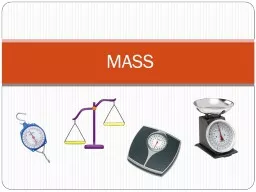

Distinguish among different units of mass g kg tonnes Convert g to kg and vice versa Distinguish between heavy and light Mass in our everyday life Measuring Instruments Analog and digital scale ID: 933754
Download Presentation The PPT/PDF document "MASS Objectives By the end of the sectio..." is the property of its rightful owner. Permission is granted to download and print the materials on this web site for personal, non-commercial use only, and to display it on your personal computer provided you do not modify the materials and that you retain all copyright notices contained in the materials. By downloading content from our website, you accept the terms of this agreement.
Slide1
MASS
Slide2Objectives
By the end of the section/lesson, students should be able to:
Distinguish among different units of mass (g, kg, tonnes)
Convert g to kg and vice versa
Distinguish between heavy and light
Slide3Mass in our everyday life
Slide4Measuring Instruments
Slide5Analog and digital scale
Analog scale
Digital scale
Slide6Different types of scale
SPRING BALANCE
HEAVY WEIGHT BALANCE
Slide7Bathroom scale
Slide8Digital and Analog display
The digital display The analog display
These scales are used to weigh the body mass.
Slide9Activity
1:
Estimating and weighing body mass
Step 1: Students estimate their mass and record in their copy book
Step 2: Students weigh their body mass using the bathroom balance (given) and note in their copybook.
Student 1:
Student 2:
Student 3:
Student 4:
Student 5:
The teacher brainstorm with the students, about body mass and the units of measurement.
Slide10Mass in kilogram
The scale is indicating 1 kg for the 5 bananas.
Here the spacing is 1 unit and the mass is read in kilogram or kg
Slide11Consolidation Work
What is the mass of the apples?
A. 2 kg
B. 0.2 kg
C. 20 kg
D. 12 kg
Slide12Consolidation Work
What is the mass of the packet of sugar?
A. 0 kg
B. 5 kg
C. 50 kg
D. 25 kg
Slide13Consolidation Work
What is the mass of this packet of rice?
A. 6 kg
B. 16 kg
C. 60 kg
D. 4 kg
Slide14Mass in gram
This cheese weighs 200 g
In this case, the divisions in red, represent 100 g, while each spacing in black shows 10 g.
Slide15Example
What is the mass of the packet of butter in gram (g)?
A. 350 g
B. 200 g
C. 325 g
D. 300 g
Slide16Example
How much does a packet of lentils weigh?
A. 515 g
B. 600 g
C. 500 g
D. 525 g
Slide17Example
What would be the mass of the potato chips?
A. 70 g
B. 750 g
C. 850 g
D. 800 g
Mmm, that’s a huge packet of crunchy chips!!!
Slide18Digital Scale
The mass of the chicken can be read directly from the screen of the digital balance. It weighs 2.5 kg.
Slide19Example
Try to read the mass of the grapes.
A. 1.8 kg
B. 1.2 kg
C. 12 kg
D. 1.0 kg
Slide20Activity 2: Differentiate Between Gram (g) And Kilogram (kg)
Provide students different goods (e.g., macaroni packet, books, pencil, eraser - masses in g and kg)
A pair is designated in each group - to weigh the items and note down in the copy book; to read the mass from the packaging
Measurement of masses in kg and g is brainstormed with the students. (What characteristic of the mass makes it possible to weigh in g or kg?)
Finally the students are questioned as to what would be the unit to weigh a wool ball.
Slide21Consolidation work
Click on the unit of measurement you would use for each of the objects shown.
A. g
B. kg
A. g
B. kg
A. g
B. kg
Slide22Consolidation Work
A. g
B. kg
A. g
B. kg
A. g
B. kg
A. g
B. kg
Slide23Consolidation Work
A. g
B. kg
A. g
B. kg
A. g
B. kg
Slide24Heavier or Lighter…
Remember the seesaw at the kindergarten!!
Who is lighter and who is heavier…
Slide25Using the beam balance to compare masses…
Use the same logic and click on the object which is lighter
A
B
Slide26Using the beam balance to compare masses…
Now, which fruit is heavier, A or B?
A
B
Slide27Using the beam balance to compare masses…
And which vegetable is heavier, A or B?
A
B
Slide28Using the beam balance to compare masses…
What can you say about these two objects?
Slide29Measuring Mass Using Arbitrary Units
Given that one (1) soap weighs 100 g, compare and click the correct mass of the packet of macaroni:
A. 200 g
B. 125 g
C. 500 g
D. 550 g
Slide30Measuring Mass Using Arbitrary Units
Given that one (1) soap weighs 100 g, compare and click the correct mass of the mushroom tin:
A. 410 g
B. 25 kg
C. 400 g
D. 420 g
Slide31Measuring Mass Using Arbitrary Units
Given that one (1) soap weighs 100 g, compare and click the correct mass of the packet of biscuit:
A. 50 g
B. 100 g
C. 200 g
D. 220 g
Slide32Measuring Mass Using Arbitrary Units
Given that one (1) soap weighs 100 g, compare and click the correct mass of the following objects:
A. 1050 g
B. 100 kg
C. 1002 g
D. 1000 g
Slide33End of the
Section/Lesson: Mass